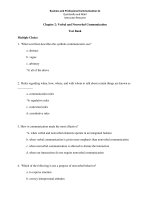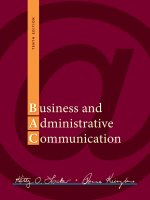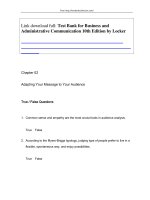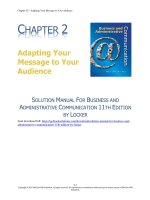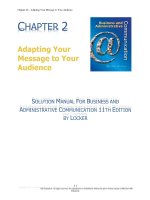Lecture Business and administrative communication: Chapter 15 - Kitty O. Locker, Donna S. Kienzler
Bạn đang xem bản rút gọn của tài liệu. Xem và tải ngay bản đầy đủ của tài liệu tại đây (435.46 KB, 19 trang )
Chapter 15
Researching Proposals
and Reports
Copyright © 2015 McGrawHill Education. All rights reserved. No reproduction or distribution without the prior written consent of McGrawHill Education.
Steps in Report Writing
1. Define the problem
2. Gather necessary data
3. Analyze the data
4. Organize the information
5. Write the report
152
Formal vs. Informal Reports
Formal reports contain formal elements:
Title page
Transmittal
Table of contents
List of illustrations
Informal reports may be memos, letters,
e-mail, sales figures, etc.
153
Report Classifications
Information reports collect data for reader
Analytical reports interpret data but do not recommend
action
Sales reports
Quarterly reports
Annual reports
Audit reports
Make-good or pay-back reports
Recommendation reports recommend action or a solution
Feasibility reports
Justification reports
Problem-solving reports
154
Report Classifications, continued…
Some reports combine information,
analytical, and recommendation types
Accident reports
Credit reports
Progress reports
Trip reports
Closure reports
155
Defining Report Topics
Real problem
Important enough to be worth solving
Narrow but challenging
Real audience
Able to do recommended actions
156
Defining Report Topics, continued…
Data, evidence, and facts
Convey severity of problem
Prove that recommendation will solve
problem
Available to writer
Comprehensible to writer
157
Purpose Statement
Makes three things clear
Organizational problem or conflict
Specific technical questions that must be
answered to solve problem
Rhetorical purpose the report is designed to
achieve
Explain - Recommend – Request - Propose
158
Research Types
Primary research gathers new data
Surveys
Interviews
Observations
Secondary research retrieves information
that someone else gathered
Library research
Online searches
159
Criteria for Evaluating Web
Sources
Authors
What person or organization sponsors site?
What credentials does author have?
Objectivity
Does site give evidence to support claims?
Does it give both sides of issues?
Is the tone professional?
1510
Criteria for Evaluating Web Sources,
continued…
Information
How complete is information?
What is it based on?
Currency
How current is the information?
Audience
Who is the intended audience?
1511
Surveys, Questionnaires, and
Interviews
Survey—questions large groups of
people, called respondents or subjects
Questionnaire—written list of questions
that people fill out
Interview—a structured conversation
with someone who will be able to give
useful information
1512
Questions to Consider about
Surveys
1.
2.
3.
4.
5.
Who did the survey and who paid for it?
How many people were surveyed and
how were they chosen?
How was the survey conducted?
What was the response rate?
What questions were asked?
1513
Characteristics of Good Survey
Questions
Ask only one thing
Are phrased neutrally
Are asked in an order that does not
influence answers
Avoid making assumptions about the
respondent
Mean the same thing to different people
1514
Question Types
Closed questions—limited
number of possible responses
Open questions—unlimited
responses possible
Branching questions—direct
subjects to different parts of
questionnaire based on
answers to earlier questions
1515
Question Types, continued...
Multiple choice—make the answer
categories mutually exclusive and
exhaustive
Probes—follow up original question to
get at specifics of a topic
Mirror questions—paraphrase content
of last answer
1516
Sample Types
Convenience sample—set of subjects
who are easy to get
Judgment sample—group of people
whose views seem useful
Random sample—each person in group
has equal chance of being chosen
1517
Using Technology in Research
Online networks
Web-based surveys
Data mining
Analytics
1518
Citation and Documentation
Citation—attributing an idea or
fact to its source in report body
Documentation—listing
bibliographic information
readers would need to locate
original sources
1519



